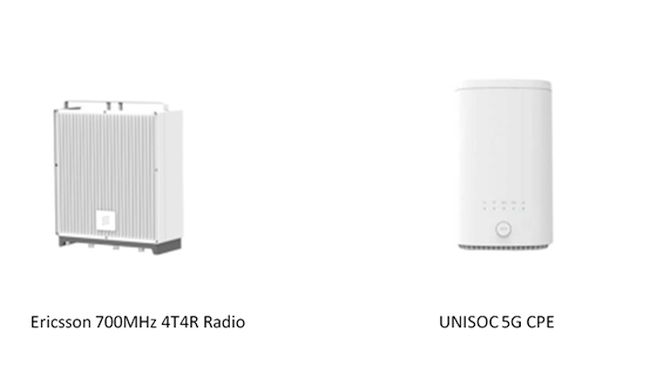SHANGHAI, Mar 8, 2021 – (ACN Newswire) – As a leading global supplier of mobile communications chipsets and IoT chipsets, UNISOC, a core subsidiary of Unigroup, together with Ericsson, has successfully completed the 5G SA NR 700MHz downlink 4×4 MIMO test compliant with 3GPP R15 specifications. The latest Interoperability Development Testing (IoDT) was carried out at Ericsson Beijing Lab on Ericsson’s 700MHz 4T4R wireless network and 5G Customer Premise Equipment with UNISOC’s 5G chipset V510 inside.
Based on the 5G CPE with UNISOC V510 chipset inside and Ericsson n28 frequency band network, the average peak of download rate could reach more than 600 Mbps. The results of the interoperability test, which were much higher than 700MHz 1T2R commercial mobile phones, broke the record for 5G network downlink peak rate under the sub-1GHz low frequency band, expanding the application field of 5G low frequency.

“The collaboration between Ericsson and UNISOC on 5G NR 700MHz extends the 700 MHz ecosystem from cellphones to a wider range of terminal forms including CPE, providing more scenarios for the use of 700 MHz in China and the global commercial market,” said Peng Junjiang, General Manager of the Research and Development Department of Ericsson in Northeast Asia.
Xia Xiaofei, Vice President of the UNISOC Market Management Department, said: “The successful interoperability test of the downlink 4×4 MIMO in the 700MHz frequency band will support operators to deploy new 5G NR network more efficiently. We will continue to deepen cooperation with Ericsson and accelerate the commercialization of global 5G networks. Together, we will contribute to the growth of 5G industry.”
UNISOC has launched a number of 5G chipsets, including the world’s first 6nm EUV 5G SoC, the UNISOC T7520, UNISOC’s first 5G baseband chip based on Makalu communication technology platform, the UNISOC V510, and its first 5G smartphone solution, the UNISOC T7510. The UNISOC 5G chipset solution has now completed interoperability testing with 5G infrastructure vendors, as well as 5G chip authentication, enabling UNISOC-powered 5G terminal adaptability across mobile operator world networks. See www.unisoc.com.
